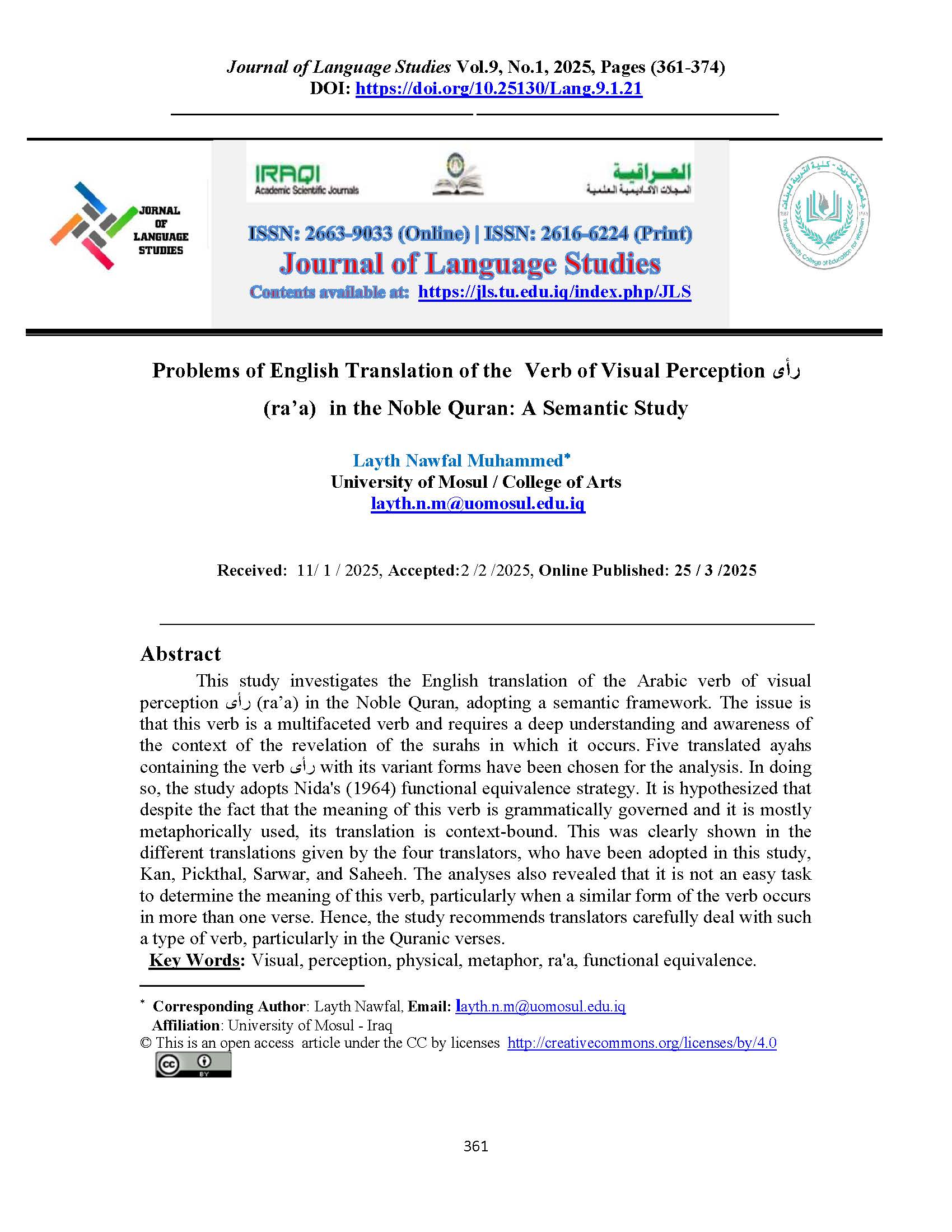Problems of English Translation of the ‘Verb of Visual Perception رأى (ra’a)᾽ in the Noble Quran: A Semantic Study
DOI:
https://doi.org/10.25130/Lang.9.1.21Keywords:
Visual, perception, physical, metaphor, ra'a, functional equivalenceAbstract
This study investigates the English translation of the Arabic verb of visual perception رأى (ra’a) in the Noble Quran, adopting a semantic framework. The issue is that this verb is a multifaceted verb and requires a deep understanding and awareness of the context of the revelation of the surahs in which it occurs. Five translated ayahs containing the verb رأى with its variant forms have been chosen for the analysis. In doing so, the study adopts Nida's (1964) functional equivalence strategy. It is hypothesized that despite the fact that the meaning of this verb is grammatically governed and it is mostly metaphorically used, its translation is context-bound. This was clearly shown in the different translations given by the four translators, who have been adopted in this study, Kan, Pickthal, Sarwar, and Saheeh. The analyses also revealed that it is not an easy task to determine the meaning of this verb, particularly when a similar form of the verb occurs in more than one verse. Hence, the study recommends translators carefully deal with such a type of verb, particularly in the Quranic verses.
References
- Al Mu'jam Al Waseet Arabic to Arabic Dictionary( 5th Edition ) Publisher: Dar Kotob al-Ilmiya & Maktaba al-Shuruq al-Duwaliyya.
- Al-Asmer, S. (2007). Alfaz al-aql wa al-jawarih fi Al- Quran Al-Kareem:A quantitative semantic study.Unpublished master’s thesis. Najah National University
- Al-Hashimi, Ahmed. (2019) Jawahir Elbalagha fe Almaani wal Bayan wal Badii. Al-Hindawi,York House, Sheet St. UK.
- Al-Hilali M.T. & Khan, M. M. (2006). Translation of the Meanings of The Noble Qur‟ān in the English Language. Published by Mujamma Al-Malik Fahad liteba’at Al-Mus’haf Ash-Sharif Fi Al-Madinah Al-Munawarah
- Al-Qortoby, Abu A. (2006). Al-Jami li Ahkam Al-Quran wa Al-Mubayen Lima Tadammanahu min Al-Sunna Wa A'ay Al-Quran. (1st ed.). Revised by Al-Turki, A. & Areqsusi, M. Mussasat Al-Risala.
- Al-Zemekhshery, Mahmood.( 1998). Assas Elbalagha. Dar al Kutub alilmyah Beirut, Lebanon.
- Aneva,T. (n.d.) ''The Semantic Network of See'': A corpus Based Study. At Shumen University, Culture and FLT - Volume 7.Shumen, Bulgaria,
- Atabari, Muhammed Ibn Jareer. Jami' al-Bayan fe Tafsir the Qur'an. Dar Al- kutub Al-ilmiya. Beirut, Lebanon.
- Breton, D. (2017). Sensing the world: An anthropology of the senses. Bloomsbury.
- Crystal, D. 1964. A liturgical language in a linguistic perspective. New Black friars 46(534): 148–156.
- Elwa, Abdelhamid. (2014).'' Features of Translating Religious Texts.'' Journal of Translation, Volume 10(1).
- Goldstein, E., & Brockmole, J. (2016). Sensation and perception.Wadsworth
- Hamdan, M. I., & Hussein, G. M. (2024). “Applying Larson's Model To Assess the Quality of Two Translations of Antony Hope's Novel The Prisoner of Zenda into Arabic”. Journal of Language Studies, 8(1), 281-304.
- Hasan, A. (1975). Al-Nahu Al-Wafi. Egypt: Dar Al-Ma'ariF
- Ibarretxe-Antu.ano, I. (2013b). ''The relationship between conceptual metaphor and culture''. Intercultural Pragmatics, 10(2),315–339.
- Ibarretxe-Antu.ano, I. (2019). Perception metaphors in cognitive linguistics: Scope, motivation, and lexicalization. Perception metaphors (pp. 43–64). John Benjamins
- Ibn Ashoor, Muhammed Taher. (1984) Al – Tahirir wal Tanweer. Tunisian Publishing House.
- Ibn Kathir, Hafiz, Tafsir the Great Quran. Publisher: Dar Ibn Hazm
- Ibn Munzur, Muhammed Ibn Mukaram (1883). Lisan Al - Arab. Dar Sadir - Beirut (3rd ed)
- Jumaah, R.,Rashid,S., Abdul Jabar, A. &Ali, A. (2020).'' A Cognitive Semantic Analysis of Arabic Verb of Visual Perception رأى (ra’a) in Fiction Writing.'' Journals.sagepub.com/home/sgo Sage.
- Lakoff, G., & Johnson, M. (1980). Metaphors we live by. The University of Chicago Press.
- Lakoff, G., & Johnson, M. (1999). Philosophy in the flesh: The embodied mind and its challenge to western thought. Basic Books.
- McGregor, W. B. (2009 ). Linguistics: An Introduction. London: continuum.
- Nida, E.A., (1964a).Тowards a Science of Translating. E. J. Brill: Leiden
- Pickthall, M. M. (1930). The Meaning of the Glorious Qur‟an: Text and Explanatory Translation. New York: Muslim World League.
- Pink, S. (2015). Doing sensory ethnography (2nd ed.). Sage
- Safi, S. H. & Farman, A. Y. (2023). “Translating the Particle ‘لام’ /laam/ in the Noble Qur’aan into English”. Journal of Language Studies, 8(1), 214-235.
- Safi, S. H. (2024). “Translating Personification in Prophetic Hadith into English”. Journal of Language Studies, 8(10), 286-304.
- Saheeh International. (1997). Translation of the Meaning of the Qur’an Abul- Qasim Publishing House. King Fahd National Library Cataloging-in-Publication Data.
- Sarwar, H. (1920). Translation of The Holy Quran. (1st ed.). England
- Sawaluddin, S., Hitami, M., Darussamin, Z., & Sainab, N. (2018).''The potential of the senses in al-Quran as the basic elements of the human physic and its application in learning''. Advances in Social Science, Education and Humanities Research, 261, 158–162.
- Sekuler, R., & Blake, R. (2005). Perception. McGraw-Hill. Sempo, W., Rosalina, A., Adawiyah, M., Zainudin, W. N. R. A. B.,
- Sempo, W., Rosalina, A., Adawiyah, M., Zainudin, (2017). ''The Quranic philosophy on superiority of audio sense against visual sense based on the book of exegesis and science reports''. dvanced Science Letters, 23(5), 4765–4768.
- Serres, M. (2016). The five senses: A philosophy of mingled bodies. Bloomsbury.
- Siregar, Z. (2016).'' Alma’any af’al alhwas alkhams fi alsiyaq Al-Qurani": The meanings of the five senses in the Quranic context and their educational implications. Jurnal Pendidikan Islam, 28(1), 156–184.Studies in Linguistics, Culture and FLT – Volume 7. Shumen University,
- Sweetser, E. (1990). From etymology to pragmatics. Metaphorical University of Chicago Press.
- Viberg, Å. (1983). ''The verbs of perception: a typological study''. Linguistics, vol. 21, no. 1,123-162
- Whitt, R. J. (2010). Evidentiality and perception verbs in English and German. Oxford, Bern: Peter Lang
- Zade, H., & Esfahani, M. (2015). Synethesia in the Holy Quran: Functions and aesthetics. Studies on Arabic Language and Literature, 21, 49–72.

